Warm floor under the laminate: choose which is better to put + an example of work
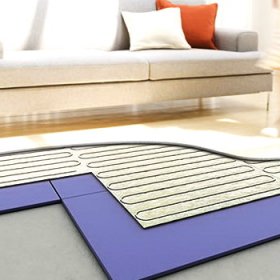
Thanks to modern materials, wooden floors that have been popular for a long time are successfully replaced by laminate. They have the appearance of wood, but much cheaper. However, no matter how high-quality they are, they will not warm without a heating system. Laying a warm floor - one of the options for creating a comfortable temperature in the room. Moreover, this method of heating is much more efficient than radiator. A person feels more comfortable when the floor temperature is slightly higher than the air temperature at head level. It remains to choose what a warm floor under the laminate is better to put.
Content
Which system is better to lay under the laminate?
There are three varieties of underfloor heating:
- water;
- electric cable;
- electric infrared.
All of them have common advantages:
- uniform heat distribution;
- system efficiency;
- aesthetics, since the heating elements are hidden from the eyes and do not spoil the interior of the rooms;
- there is no dust circulation as with radiator heating.
Let's get to know each of them better.
Water floor heating
Such a floor heating device consists of several layers. The first of them is a waterproofing coating, laid on the base. At this stage, laying the damper tape around the perimeter of the room.
The second layer is thermal insulation. A heating pipe of small section is laid out on it. Then comes the carrier layer, which is most often used concrete screed, less commonly - materials based on gypsum fiber. On top of these layers lay a floor covering. Heating is due to the warm water circulating through the pipes. Depending on the type of overlap, the thickness of the warm water floors is 5-15 cm.
Benefits:
- safety;
- reliability;
- independence from power supply (subject to natural circulation of the coolant).
Disadvantages:
- installation complexity;
- the need to fill pipes with concrete screed;
- reduces the height of the room;
- complexity of repair (in case of coolant leak).
An article about which pipes to choose for installing a warm water floor may be useful to you:https://aquatech.tomathouse.com/en/otoplenie/teplyj-pol/truby-dlya-vodyanogo-teplogo-pola.html.
Electrical cable
The main element of an electric floor heating is a cable. The room is heated due to the fact that it converts electrical energy into heat. For electric underfloor heating, two-core and single-core cables are used. In the first embodiment, two cores: supply and heating.For residential premises, it is better to use a two-core cable, since it has less electromagnetic radiation. In addition, it is easier to stack. However, due to the possibility of breaking the contact of the cable, there is a possibility of overheating.
To avoid this situation, self-regulating cable is used for underfloor heating. If overheating occurs in a certain area, then in this place the cable resistance increases, which prevents the temperature from rising. Begin installation of such a system with surface preparation. Before laying the cable, clean the surface of the floor, if necessary, level it and cover it with a heat-insulating material. On top make a thin screed (0.2-0.3 cm) using a reinforcing mesh and allow it to dry for at least two days. Then attach the mounting tape.
Having determined the location of the thermostat, the heating cable is laid according to the manufacturer's recommendations. After fixing the sensor and thermostat, the system is tested. After making sure that it is working, fill the screed (3-10 cm). It will be possible to lay the laminate on the warm floor in 30 days, when the screed acquires the necessary strength. Also, underfloor heating can be done using heating mats. Their installation is a little easier, since the cable is fixed using a grid.
Benefits:
- reliability;
- durability, service life more than 20 years;
- ease of installation and maintenance;
- the ability to control the optimal room temperature.
Disadvantages:
- weak electromagnetic radiation;
- high cost of energy.
Electric warm can be used not only in rooms, but also on a loggia. It is only necessary to comply with all installation rules. Read more about this in our article:https://aquatech.tomathouse.com/en/otoplenie/teplyj-pol/teplyj-pol-na-balkone.html.
Infrared film
The latest development in the field of underfloor heating is infrared film. It is laid on heat-reflecting material, and coated with polyethylene on top. Then you can immediately lay the finish coating.
Benefits:
- reliability and durability;
- ease of installation;
- no need to fill the screed;
- after installing the warm floors, you can immediately start laying the laminate;
- due to the small thickness of the film and the absence of screed, reducing the height of the ceilings is negligible;
- more economical use of electricity compared to a heating cable;
Disadvantages:
- high price;
- inability to use in wet rooms;
- in order not to damage the film during installation, a flat base is required.
What is the best choice?
When choosing a warm floor, it is necessary to consider the characteristics of the laminate. It contains formaldehydes, which, when the laminate is heated above 26 ° C, are released into the atmosphere. They can cause irreparable harm to health. Therefore, when choosing a laminate for laying on a warm floor, pay attention to the accompanying documentation. It should indicate whether it is allowed to install a warm floor, and which one, under this floor covering. In addition, heating the laminate over 27 ° C leads to its destruction. Analyzing all these data, it can be noted that infrared floor heating is the most successful solution for a laminate.
Steps for installing an infrared warm floor
Necessary equipment
Before purchasing the required equipment, you should calculate the amount of reflective material and thermal film. The reflective substrate is taken over the entire area of the room. The amount of infrared film is calculated taking into account that it can not be laid under furniture. Therefore, only free space is taken into account. What materials and tools you may need:
- set of underfloor heating;
- temperature regulator;
- temperature sensor;
- thermal reflective substrate;
- protective film;
- tools: scissors, screwdriver, pliers, knife, adhesive tape.
Preparing the base for laying the film
Please note that the installation of a warm floor under the laminate is carried out only on a flat surface. The base must be clean and dry before installing the underfloor heating. Heat-reflecting material with a dense layer is laid on the entire floor surface.
Do not use materials based on aluminum foil as a heat reflector for infrared floors.
Between him they fix it with tape. After laying the substrate, the location of the thermostat is determined. If a built-in device is used, a strob is made for it and the lead wires.
Installation of thermal strips and network connection
To lay a film warm floor, it is necessary to cut it into strips. With a film width of 0.5 m, the strip length should not exceed 13 m, at 0.8 m - 10 m and at 1 m - 7 m.
To minimize the number of cuts and connection points, it is better to lay thermal strips along the length of the room
Lay the thermal strips at a distance of at least 1 cm from each other and 5 cm from the walls. In this case, the copper strip should be below.
To reduce the length of the connected wires, arrange the strips with the contacts to the wall on which the thermostat will be placed. It is impossible to impose thermal films on one another!
All unused tire cuts must be covered with bitumen insulation. The connection of the bands is carried out in parallel. Therefore, by placing the wires on one side, they can be hidden under the baseboard.
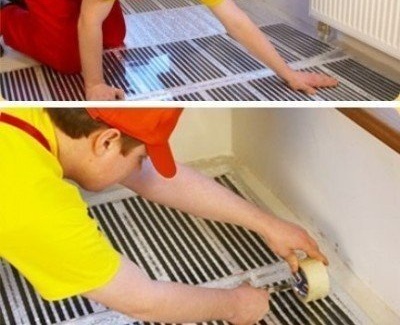
To prevent the film from popping during installation, you need to attach it with tape to the substrate
To attach the contact clamp, one end is inserted into the cavity between the silver strip and the film, and the second is fixed over the copper strip and clamped with pliers. So do with all the contacts.
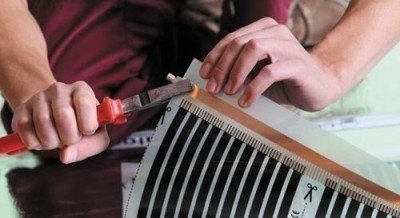
One end of the contact clamp is inserted into the space between the film and the silver strip, the other on top of the copper strip
To prevent the film from fitting during installation, it must be attached to the substrate using construction tape.
The bare wires are inserted into the contact clamps and fixed with pliers. Connection points isolate.
The temperature sensor is fixed on the black strip of the heating film from below, using bitumen insulation.

The temperature sensor is applied to a black strip at the bottom of the film and secured with bitumen insulation
To make the surface for laying the laminate as smooth as possible, cuts in the heat-reflecting substrate are made under the wires, the sensor and the contact clamps. So that the wires do not move, they are fixed with tape.

For wires and contact clamps, cuts are made in the heat-reflecting substrate. This will help to make the surface for laying the laminate as smooth as possible.
Then mount the thermostat and connect wires to it. Having laid the system, carry out its verification. Then put on top of the protective material and the finish flooring.
Systems with a power of more than 2 kW should be connected through a separate machine!
It is also possible to install a warm floor under a tile. Read about the rules and stages of installation in our material:https://aquatech.tomathouse.com/en/otoplenie/teplyj-pol/teplyj-pol-pod-plitku.html.
Having considered three options for warm floors, you can choose the most suitable one. Please note that the surface of the laminate must not be heated above 25 ° C. But even this is enough to make the room cozy and warm.
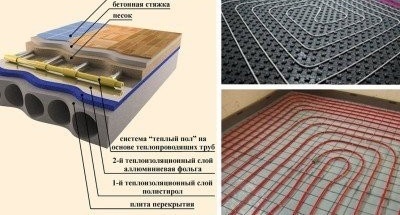
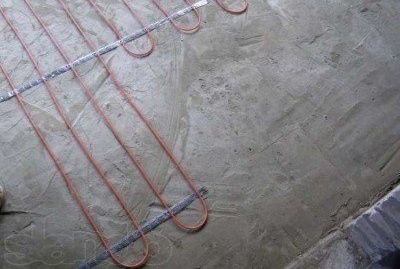
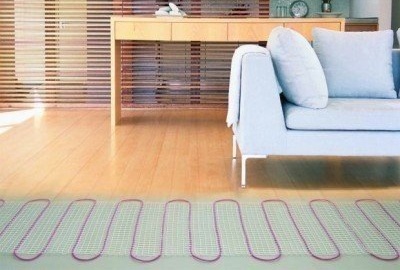
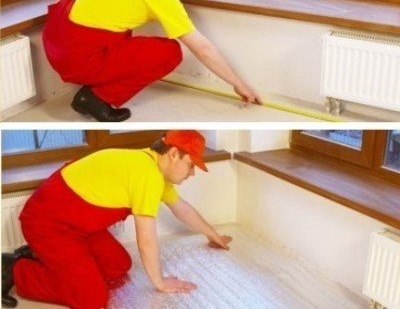
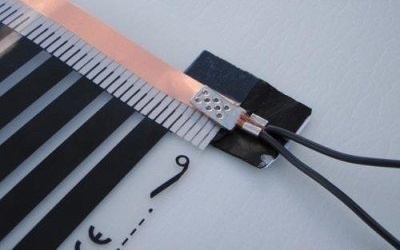
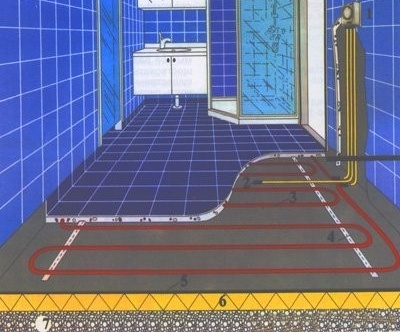


5 comments